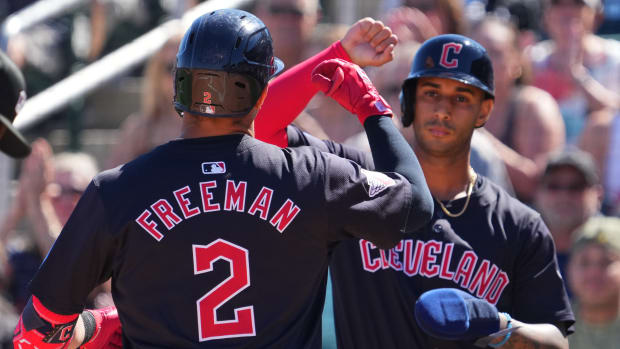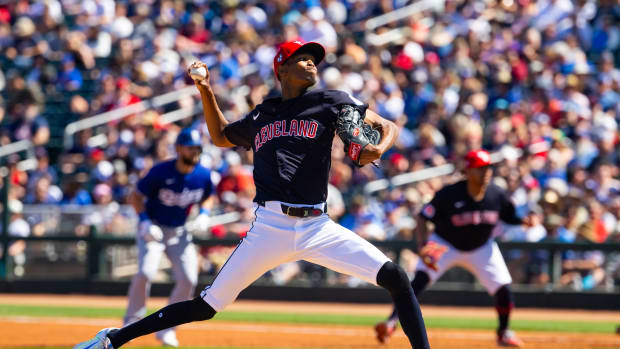It’s Time for the Indians to End Their Grab Bag Approach to the Outfield
Wednesday night, for the second time this year, the Cleveland Indians started utility infielder Mike Freeman out in left field.
Ironically, this also happened to represent the second time Freeman logged more than one outfield start in a single season since 2016.
What may read as a fun quirk to some really just shows how cloudy Cleveland’s outfield remains almost a third of the way into the 2020 campaign. Over the past few weeks, the Indians have continually mixed and matched their lineup with this area of the roster, yet success has still been hard to find.
While the amount of candidates Cleveland had on hand made this assorted approach necessary early, it’s gone on long enough. It’s time for the Indians to simply pick their starting outfielders and move forward.
To date, production from the Tribe’s outfield has been limited to say the least. Collectively, this unit has a .138/.258/.196 slash line, a 29.3% strikeout rate, and a wOBA over 100 points below average (.219).
Sure, Franmil Reyes is beginning to show signs of progress at the plate. That said, he’s spent only five innings in the outfield this year, all of which occurred during the third game of the season.
Outside of Reyes, nine other players have made at least one outfield start for Cleveland in 19 games. Only four -- Domingo Santana, Bradley Zimmer, Jordan Luplow and Freeman -- have generated an extra base hit. Santana leads the unit with two. Seven of these outfielders have struck out in at least 28.9% of their respective plate appearances.
The lack of outfield success isn’t terribly surprising. This was one area of the roster many around the league identified as Cleveland’s biggest red flag.
At the same time, the Indians’ outfield management may have a hand in the struggles we’re seeing. By continually shifting combinations, it makes it extremely difficult for any one of these players to get into a rhythm offensively.
Unfortunately, this issue wasn’t mitigated by last week’s roster reduction. The Indians were able to take two outfielders -- Greg Allen and Daniel Johnson -- out of the equation by sending them down to their satellite camp. However, both Delino DeShields Jr. and Tyler Naquin have since returned from the IL, ensuring Cleveland can keep plugging along with its grab bag approach.
Admittedly, securing a starting outfield would be simpler if a few players were at least somewhat producing. As noted above, that’s not happening.
However, we’re reaching a point where the “throw it on the wall and see what sticks” approach does more harm than good. Knowing that, Cleveland would be wise to just assign starting roles in order to finally allow for some sense of consistency.
It’s certainly not an easy call, considering there’s a lack of offense across the board. At this point, the Indians may need to just go with who they believe will benefit the most from frequent plate appearances.
They can start with Santana.
Yes, he’s established a reputation as a defensive liability. However, Santana boasts more power potential (career .193 ISO) than any other option. With a 17.8% walk rate in 45 plate appearances, he’s at the very least keeping his OBP up while Cleveland waits for his bat to come around.
Jordan Luplow may not be an everyday starter, but his historical success against left-handed pitching makes him a solid platoon option. Cleveland can pair him with Naquin, whose bounce-back performance in 2019 certainly earned him a fair share of playing time.
As for the final spot, it should come down to either Zimmer or Oscar Mercado.
Neither is performing well at the moment. Zimmer has failed to match the power he showed off in summer camp (.094 ISO). Mercado has struggled to generate quality contact in general (.132 wOBA).
If picking between the two, Cleveland may have to go with who offers the most defensively. Doing so gives Mercado the edge, as Baseball Savant currently ranks him in the 96th percentile when it comes to Outs Above Average.
The Indians can still find roles for Zimmer and DeShields, who both boast speed which makes them effective pinch runners off the bench.
However, the days of finding brand new outfield combinations to toy with need to be nearing an end.
This area of the roster is floundering right now, something which may be driven by a lack of consistency. It’s time for a change to the approach, for Cleveland to just find a starting outfield and proceed accordingly.
After all, doing so can’t be much less effective than the route the team has taken so far.




